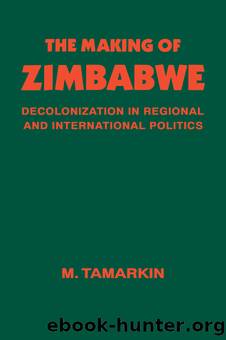The Making of Zimbabwe by M. Tamarkin

Author:M. Tamarkin [Tamarkin, M.]
Language: eng
Format: epub
Tags: History, General
ISBN: 9781136288012
Google: 9u8EPjHkId4C
Publisher: Routledge
Published: 2012-11-12T15:54:20+00:00
CHAPTER SEVEN
From International to Internal Settlement,
February 1977 â March 1978
Kissinger, despite the failure of his initiative, left a deep imprint on the process of decolonization in Rhodesia. His vital contribution was that at the level of the objectives, majority rule within a time-span broadly acceptable to most participants, at all levels of the conflict, became a new frame of reference. This was a breakthrough which proved irreversible. This was achieved, however, at the cost of maintaining confusion with regard to the nature of independent Zimbabwe and the transition period leading thereto. Because these crucial issues were left unresolved, the two strategic options â peaceful settlement and military struggle â remained open. But even at that level, Kissinger proved that through the skilful use of diplomatic resources and skills the conflict could be advanced towards a peaceful resolution. It was undoubtedly partly as a result of this lesson that the initiative in the conflict resolution effort throughout much of 1977 remained in the hands of the international actors. The international effort, which bore no fruits, gave way in November 1977 to negotiations between the Rhodesian government and internally-based moderate African groups. These negotiations culminated, in early March 1978, in an internal settlement. The internal settlement was favoured by very few. It was vehemently opposed by the PF and the FLP. The international actors laboured hard against it. South Africa clearly preferred an internationally recognized settlement. At least some of the signatories to the internal settlement would rather have been involved in negotiating an internationally recognized one. The internal settlement came to pass because its opponents did not produce sufficient energy â military, political or diplomatic â to effect their favoured solution. Furthermore, their actions and abstentions contributed to the ripening of the conditions in which the internal option emerged.
The concept of internal settlement was not, as we have seen, a new one. It was not merely a threat used by Smith whenever faced with âextremeâ demands. It was, in fact, inherent to the political philosophy of white Rhodesia. The Rhodesian brand of multi-racialism, allowing marginal black participation in the white-dominated political system, was, in essence, an internal settlement designed to perpetuate white control and privilege. The incorporation of Africans in the Cabinet in 1976 was indicative of the expansive potential of this option. The formation of ZUPO in late 1976 was designed to confer upon this option a measure of modernity and respectability. However, even before the Portuguese decolonization introduced a new impetus to the Rhodesian conflict system, the government was well aware of the limitations of a solution resting solely on a collaborating group devoid of nationalist legitimacy. Thus in 1973, as we have seen, Smith began negotiating an internal settlement with Muzorewa. However, what Smith offered to the Africans was not sufficient to entice even the moderate ANC. In the aftermath of the Victoria Falls bridge conference, Smith negotiated an internal settlement with Nkomo, a leader possessing both nationalist credibility and regional support. But even the radically changing regional
Download
This site does not store any files on its server. We only index and link to content provided by other sites. Please contact the content providers to delete copyright contents if any and email us, we'll remove relevant links or contents immediately.
| Africa | Americas |
| Arctic & Antarctica | Asia |
| Australia & Oceania | Europe |
| Middle East | Russia |
| United States | World |
| Ancient Civilizations | Military |
| Historical Study & Educational Resources |
Goodbye Paradise(2971)
Men at Arms by Terry Pratchett(2408)
Tobruk by Peter Fitzsimons(2064)
Pirate Alley by Terry McKnight(1910)
Arabs by Eugene Rogan(1838)
Borders by unknow(1789)
Belonging by Unknown(1472)
The Biafra Story by Frederick Forsyth(1326)
It's Our Turn to Eat by Michela Wrong(1305)
Botswana--Culture Smart! by Michael Main(1238)
A Winter in Arabia by Freya Stark(1225)
Gandhi by Ramachandra Guha(1196)
Coffee: From Bean to Barista by Robert W. Thurston(1183)
Livingstone by Tim Jeal(1152)
The Falls by Unknown(1142)
The Source by James A. Michener(1135)
The Shield and The Sword by Ernle Bradford(1101)
Egyptian Mythology A Fascinating Guide to Understanding the Gods, Goddesses, Monsters, and Mortals (Greek Mythology - Norse Mythology - Egyptian Mythology) by Matt Clayton(1088)
Africa: Altered States, Ordinary Miracles by Richard Dowden(1078)
